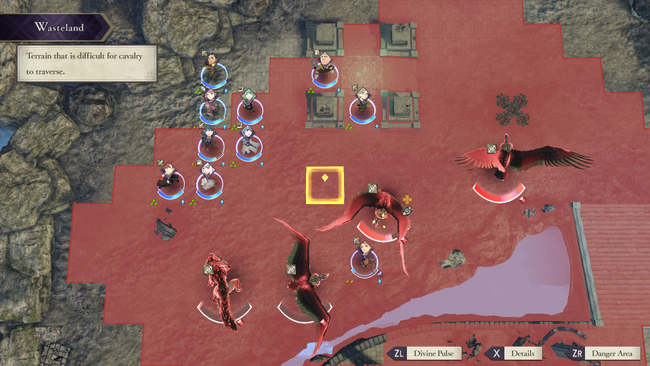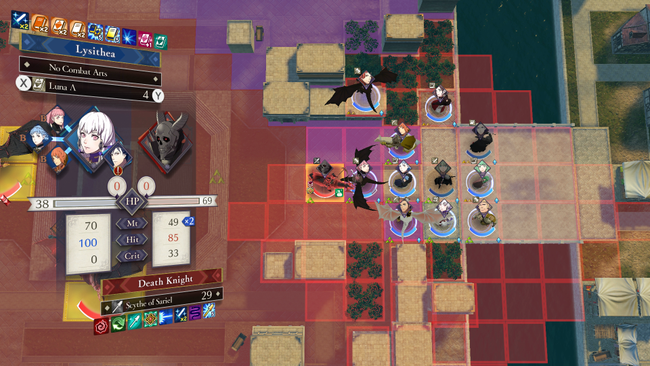Fire Emblem: Three Houses Review Addendum - The Path of Maddening Mode
Fire Emblem: Three Houses is a tremendous game. In my original review, I especially praised things like its world-building and character writing - the best the series has seen since the Tellius duology days, at least. However one of my sticking points was that the game felt just a tad too breezy as a strategy RPG. I won't repeat all my commentary here, but put briefly, I felt I was making progress through the game a little too easily, not engaging in all the systems the game offered simply because I didn't need to in order to succeed.
Since release, a new Maddening Mode difficulty level has been added to the game as a free update. These sorts of modes have become common in more recent Fire Emblem titles, sometimes referred to as Lunatic in previous games. I knew I had to try this new mode out, and since that update, I've completed a Golden Deer route playthrough on this higher difficulty level. And such, I wanted to reflect on my thoughts on this new mode and how it relates to my previous write-up. Concisely, it was a tough but rewarding playthrough.

Maddening is probably not the ideal 'Hard' mode. I doubt it's really meant to be a well-balanced way to engage the player. I look at it more a sucker punch-you-in-the-mouth mode, where you have to overcome the sometimes unfair things the game throws at you.
Maddening Mode is not just raising the stats of enemy units. There are now more enemies on each map, and many have new passive Abilities equipped, such as high-level proficiencies or the sword/lance/axe-breaker weapon triangle passives. Past a point, it almost felt like I was playing a Fire Emblem game where the classic weapon triangle had never left.
One particularly tricky Ability to manage is Pass, which allows enemies to go right through your front line defenses to target your squishy mage units in the back. Overall, you basically have to be much more careful with just about everything on this difficulty.
Battalions and gambits, something I almost ignored in my previous Hard Mode playthroughs, become absolutely essential in Maddening Mode. Not just the passive stat boosts given by having a battalion equipped, but the effects offered by gambits are now imperative. Gambits often halt the progress of a group of enemies for one turn, something that is frequently incredibly valuable to manage an onslaught of foes all gunning for your lowest Defense units. It's also valuable to train up a variety of battalions with various gambits, because certain gambits are much more useful in several situations. One particularly useful gambit is Stride, which ups the movement of a cluster of units by 5. But this isn't the case for every map, so sometimes it might make more sense to have a cluster lightning attack gambit equipped instead.
Another near-necessary gambit is "Impregnable Wall", which lowers the damage dealt from an enemy to 1, though it also lowers the player's attack to 1 as well. Despite this, I found it often useful to line up three of my units in the enemy's path and cast this Wall on them, in order to survive to the next turn -- ready to pounce in a counterattack. You only get 5 uses per map, though, and sometimes on the larger, later maps you'll need to know how to use these charges efficiently.

Character personal skills also become far more important to pay close attention to in Maddening. As an example, Flayn increases the Defense of anyone standing next to her by three. Similarly, Sylvain gains +2 Attack and Defense for being next to a female character. Likewise, Hilda increases the Attack of adjacent male characters, and Leonie gets a buff when situated next to men. So, by smartly positioning these characters, you can have Sylvain's Attack and Defense raised by 5 each, an amount that can sometimes mean the difference between success and failure. Ignatz has a natural +20 to hit, and combine that with another +20 for mastering Archer, he was very useful in hitting those dodgy enemies. Throughout my playthrough, I was constantly thinking about the positioning and movement of my units, in order to make sure everyone was situated as usefully as possible. Things like support links also become important to maximize, oftentimes to raise hit chance.
Combat Arts, too, become crucial to know your way around. You'll often find the need to raise your attack power or hit chance as high as possible because otherwise an oncoming counterattack is certain to end up fatal. Other Art effects, such as dealing extra damage to armored units, lowering defense for a turn, immobilizing a foe from range, or preventing counterattacks all become commonplace strategies where before they were often nothing more than gimmicks with limited applicable use. Similar to how Gambit use has to been carefully considered due to the limited number of casts per map, Combat Arts can burn through a weapon's durability faster than you'd think, meaning spamming them too often also comes with some repercussions. Because you will be using combat arts more frequently, you will also be spending more time with resource management with respect to money, weapons, and repairs.
Of course, nothing is stopping these techniques from being used in the two lower difficulties. It's more that the level of challenge in the lower difficulty settings is often reduced to simply slashing down enemies before such attrition strategies even become necessary.
Maddening Mode is not always fair, and I'm not saying it needs to be either - it's called Maddening (or historically, Lunatic) for a reason. There are more enemy reinforcements in some levels, and on this difficulty mode, they will reinforce and move on the same turn. This is easily the singular biggest annoyance of Maddening, as you essentially have to know the position and movement of reinforcements before they come. Luckily, having played through the game several times, I was aware of some of these positions already. Also, Divine Pulse is still in play, so there's always the opportunity to undo an unlucky hit or test out a risky strategy. To note, you only get a maximum of 10 rewinds on this mode instead of 13 - a slight restriction on the mechanic but still usually enough to make it through.

While the map and objective design in Fire Emblem: Three Houses doesn't quite reach the quality of some other Fire Emblem titles, the added resistance of Maddening Mode makes some of the various main or side objectives legitimately tricky to achieve. For example, the Paralogue 'Dividing the World' has you defending a border from the flow of enemy units. On lower difficulties, you can essentially ignore this border altogether as you go out to meet the enemy, but on Maddening this is absolutely not the case. You have to carefully keep tabs on where the enemy is coming from, how far they can move, and if you will be able to halt their progress in time. Other side objectives, like the various times you have to save villagers from enemy units, also become much more of a thoughtful challenge to achieve success.
For me, the biggest hurdle in the game was the map "Hunting by Daybreak", which is the very first map after the timeskip. A big reason this map was such a struggle was that you do not get a preparations screen, and while whatever weapons you had equipped in the previous mission are all repaired automatically, you don't get a chance to reequip from your convoy like you usually do. Also, you start out the map significantly outnumbered while your units slowly come in, separated from one another. On the Golden Deer route specifically, Ignatz and Lorenz come in paired up in a corner, immediately facing at least a half-dozen foes on them. Neither of these units had high movement or were heavy hitters, so it took a lot of care to coordinate my moves well to get them out alive. Luckily I had some good wide-hitting gambits set up that they could slow down the enemy enough, but I wonder how I would manage had I not had the right battalions on them (again you don't get a preparations screen so you are stuck with whatever they had in the previous map).
Luckily, after this point, things do become more and more manageable as you make your way to the finale of the game.
The biggest downside to Maddening is that the pacing of the game takes a shot. Not only does completing a map simply take more time, but you'll also probably want to do considerably more auxiliary battles than what is needed on other modes, because every bit of EXP and every stat-up you can get will help. I'm the type of person who doesn't like to leave opportunities on the table, so sometimes I spent 3 Free Days each month just doing battles to get my stats as high as I could. The deck is already stacked against you, so I wasn't going to give the game any favors by wasting those Free Days.
Despite Maddening not being the ideal Hard difficulty I was looking for, it still satisfied my itch for really digging into the game mechanics and coming out on top. It's extremely satisfying to play against the handicap and still result in a victory.